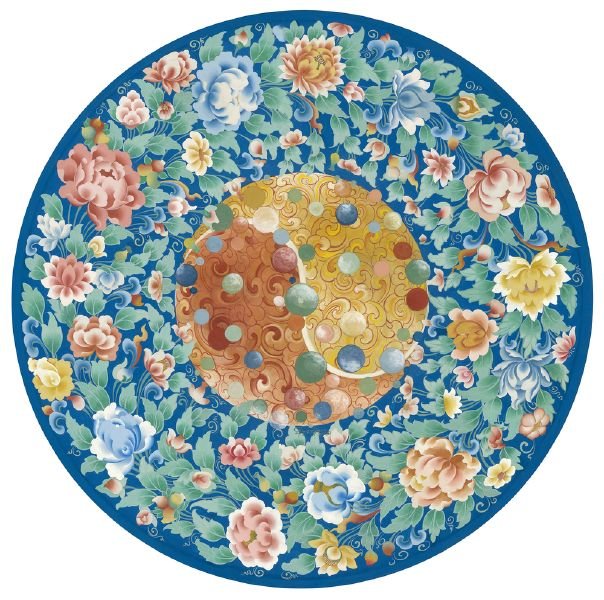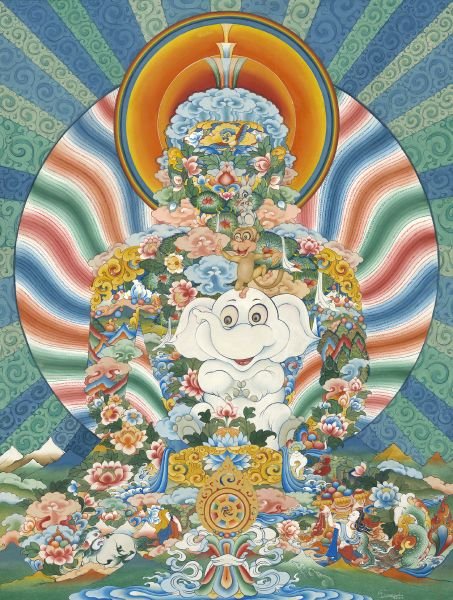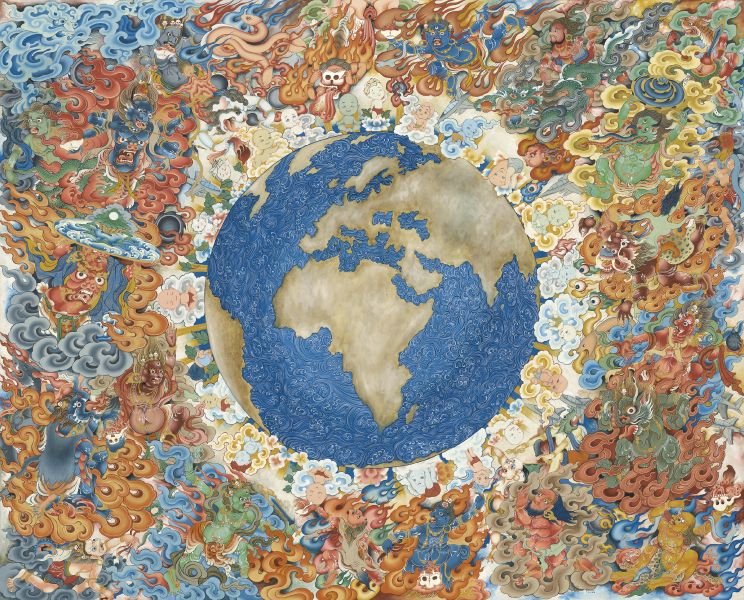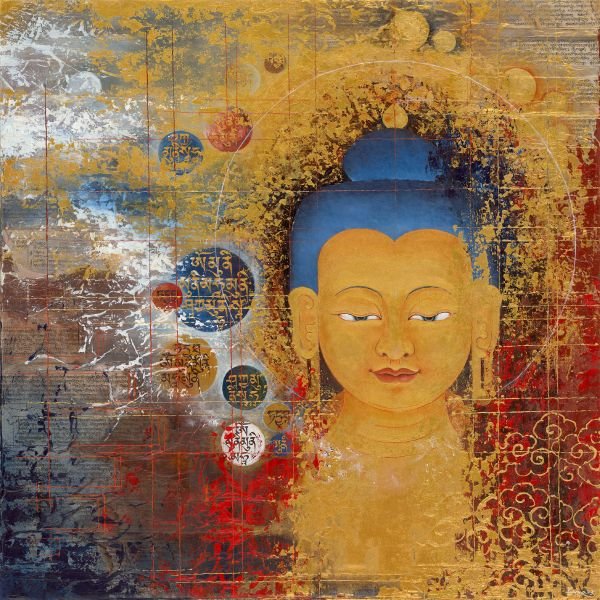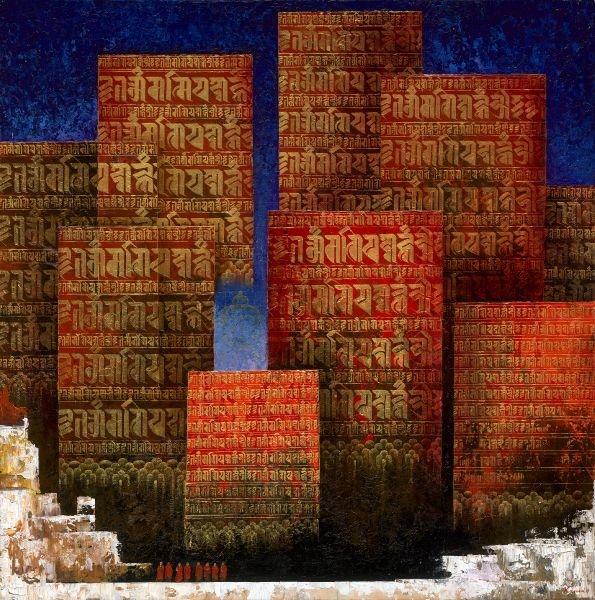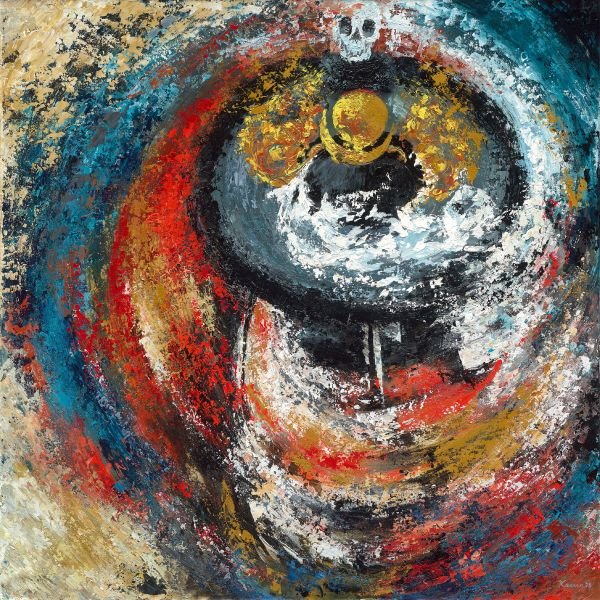Revolutionary Visionaries of Bhutanese Art Illuminate Taipei
From the distant land of Bhutan, two visionary artists — Asha Kama and Gyempo Wangchuk — have brought their latest works to the bustling heart of Taipei city. Their introspective works beckon the viewers to embark on a profound journey of contemplation, inviting us to seek meaning amidst the perpetual flux of the world.
Sense of Wander: ★★★★☆
Gyempo Wangchuk, Drukyul (2022)
TAIPEI, Taiwan — In the month of May, Taipei's art scene ignites with a contagious energy. Contemporary art fairs like Taipei Dangdai, Art Revolution Taipei, and Art Solo, all take place during this time, bringing together local and international artists. In the midst of this bustling art scene, two artists — Asha Kama and Gyempo Wangchuk — have journeyed all the way from the distant land of Bhutan to showcase their works. The serendipitous meeting with these two artists was made possible by the Tansbao Gallery, a Taipei-based sanctuary that has, since its founding in 2018, been an avid advocator of Bhutanese contemporary art.
The Bhutanese feast kicked off in late April within the walls of the Tansbao Gallery with the opening of Gyempo Wangchuk’s solo exhibition titled The Worlds Within Us. This marks the artist’s second solo exhibition in Taiwan, following his debut in 2021.
Wangchuk's latest series of works provides viewers with a profound insight into the inner workings of his creative mind. Through his artistic endeavors, he delves into profound Buddhist concepts, such as rebirth, spiritual practice, and enlightenment. However, his creations also serve as a reflection of his personal experience, deeply rooted in the cultural legacy of Bhutan and nurtured by the heritage of the greater Himalayan region. This amalgamation of collective and personal narratives results in a captivating fusion found in his art.
Wangchuk shows exceptional talent in reinterpreting traditional Buddhist narratives through his unique artistic sensibility. One such example is the depiction of Four Harmonious Friends, a common subject in Bhutanese art, featuring an elephant carrying a monkey, a hare, and a bird atop one another. This tale emphasises the significance of communal harmony and respect for seniority, embodying the values that uphold the social fabric of Bhutanese society. Wangchuk's rendition of these Buddhist symbols adopts a playful, cartoon-like approach, injecting a sense of whimsy into this traditional subject matter. The four animals are contained within a meditative figure, suggesting the artist's invitation for viewers to cultivate inner harmony and lightheartedness amidst the busyness of life.
Gyempo Wangchuk, Inner Harmony (2022)
Gyempo Wangchuk, Chaos and Peace (2023)
The use of vibrant colours, derived from pigments sourced from natural minerals, captivates the viewers' gaze. Among them, Chaos and Peace stood out to me. This piece reflects the artist's contemplation of the present state of the world, plagued by issues such as the pandemic, climate change, poverty, war, and inequality. Externally, Wangchuk incorporates representations of the three evils in Buddhism: desire, anger, and ignorance, symbolising the suffering prevalent in the lower realms as often depicted in Buddhist art. However, amidst the chaos and the world, a ring of hope emerges: children. They serve as a beacon of optimism and possibility, evoking a sense of renewal and the potential for a brighter future.
Wangchuk's artistic expression is deeply rooted in his training in traditional thangkas, a form of devotional art prevalent in the Himalayan region and integral to the practice of Buddhism. His talent was soon recognised when his thangka won the national first prize in Bhutan for two consecutive years. Despite earning acclaim as Bhutan's foremost traditional painter, Wangchuk exhibited the courage to break free from convention and explore a new artistic language that embodies the spirit of the 21st century.
Breaking tradition is undoubtedly a difficult journey, as Wangchuk openly acknowledged during the artist talk held on the opening day of the exhibition. With a humble demeanor and a perpetual smile gracing his face, the artist expressed, "Even today, I find it difficult to break free from tradition." Having been raised as a Buddhist monk before receiving his artistic training in a traditional school, Wangchuk carries a profound responsibility to uphold and pass down the rich artistic tradition of Bhutan, more so than anyone else.
In one of the artist’s latest works, Technology Tree, Wangchuk showcases his unique artistic sensibility by interpreting contemporary themes. A graceful hand, reminiscent of the Bodhisattva's, is seen bestowing boons on a flowering plant. But this is no ordinary plant; it is ornamented with icons of various social media applications. Wangchuk refrains from making comments on the positive or negative impact of technology's ever-changing landscape. Instead, he invites viewers to reflect on the evolving nature of our world and consider how our present actions may shape our future.
Wangchuk's artistic output is limited, with only a dozen paintings created each year. Each of these artworks acts as a portal, enticing viewers to embark on a transformative journey from the realm of the tangible and material to the depths of the artist's inner world. Through his mesmerising and kaleidoscopic iconography, which evokes the effect of trompe l'oeil, we are transported to a realm that is both intriguingly familiar and captivatingly different.
Recently, Wangchuk became the first artist to have his work featured on the cover of the prestigious Rubin Museum of Art's journal, "Spiral". In addition, his nomination for the 19th Outstanding Asian Art Award by the Sovereign Art Foundation further validates his artistic prowess. These accolades, coupled with Wangchuk's unwavering commitment to exploring uncharted territories, serve as a testament to his artistic vision and relentless dedication to creative pursuits.
Gyempo Wangchuk, Technology Tree (2022)
Wangchuk’s path to contemporary art was sparked by his encounter with Asha Kama — the Father of Bhutanese contemporary art — in 2012.
Born in 1958, Asha underwent a decade of formal training in thangka painting and was among the first generation of Bhutanese artists to study abroad. After completing his studies at the Kent Institute of Art and Design in England, he returned to Bhutan, bringing with him new perspective and techniques. Kama's most significant contribution to the Bhutanese art scene is none other than the founding of VAST (Voluntary Artists Studio Thimphu), an organisation dedicated to nurturing artists and promoting contemporary art education in Bhutan.
Following the inauguration of Wangchuk's solo exhibition, Asha Kama's solo exhibition, Sacred Present, unveiled at the esteemed De-Ming Gallery located within the Dr. Sun Yat-Sen Memorial Hall. This remarkable exhibition invites viewers to immerse themselves in Asha Kama's artistic realm, where Bhutanese traditions seamlessly fuse with contemporary expressions, offering a captivating glimpse into the artist’s world of divine inspiration.
Asha Kama, Om Muni Muni A Tribute to Shakyamuni II (2023)
Kama’s oeuvres span across a diverse range of Buddhist subjects, from the Buddha to mandalas, the sacred dance to the prayers’ wheels. In one series, the artist portrays an abstraction of the shana dancers, believed to subjugate demonic forces through movements and gestures. In another series, vibrant calligraphic mantras in gold adorn a lively red background, evoking a sense of sacredness. When standing before these embodiments of prayers, I couldn't help but believe, even if just for a moment, that I could set the prayer wheels in motion with a gentle touch as I passed by. The illusion was so convincing, as if the artwork held a tangible connection to the sacred ritual, beckoning me to partake in its ancient practice.
Kama's aspiration to create a thousand paintings of Buddha as a tribute to the sacred is reflected in his works. One notable piece, Om Muni Muni A Tribute to Shakyamuni II, stands as an embodiment of this artistic endeavour.
His depictions of the Buddha bear deliberate traces of the gridlines used in traditional thangka painting, serving as both a nod to tradition and a reinforcement of the dichotomy between the old and the new. Through his bold deconstruction of the traditional image and measurement framework, Kama has created an interplay of reality and illusion, giving his somewhat abstract Buddha depictions a unique presence. When gazing into the eyes of the Buddha, it is as though I were confronted with an unyielding force of love and compassion, beckoning me to delve deeper into their innermost selves and to attain a state of spiritual transcendence.
It is not farfetched to say that Kama's work serves as an extended invitation to the viewer, encouraging them to connect with their own spirituality and engage their body, mind, and spirit.
In 2010, Kama was honoured with the National Order of Merit, bestowed upon him by the current King of Bhutan in acknowledgment of his significant contributions to Bhutanese art.
Asha Kama, Prayer Wheel Series IV (2018)
Asha Kama, Prayer Series II (2018)
In the midst of the towering Himalayas lies Bhutan — the happiest country on earth — that gradually emerges from its seclusion through political and economic reforms. This newfound openness gives rise to a fresh artistic wave led by visionaries like Asha Kama and Gyempo Wangchuk, who are reshaping the landscape of Bhutanese art.
However, it is crucial to note that the artists’ departure from tradition is not a mere challenge, but a means to express their inner selves. Throughout their artistic journeys, Kama and Wangchuk grapple with fundamental questions: "How much of tradition should be kept?" and "What is the ideal balance between tradition and innovation?" As their works have shown, tradition and innovation are not opposing forces, but rather complementary aspects. By breathing new life into traditions, a new face of Buddhist art is born.
In a sense, the essence of Bhutanese traditions remains unchanged in the works of Wangchuk and Kama. In fact, I see their creations as traditional thangka taking on a contemporary form. Though their appearance may have shifted, they continue to possess a spiritual essence that beckons us to embark on a journey of contemplation and introspection, encouraging us to delve into the depths of our being and find purpose amidst the perpetual flux of the world.
And this artistic revolution led by Kama and Wangchuk extends beyond the artists themselves. It marks the beginning of a new chapter in the nation's illustrious history, where tradition and innovation harmoniously coexist. As these visionaries delve into uncharted expressive modes, they are also forging a new kingdom that is distinctly Bhutanese.
Asha Kama, “Shana” A Black Hat Dancer (2023)
Asha Kama's solo exhibition, Sacred Present, was on view at the De-Ming Gallery at the Dr. Sun Yat-Sen Memorial Hall from April 29 to May 7, 2023. The Worlds Within Us, a solo exhibition by Gyempo Wangchuk, is now on view at Tansbao Gallery until May 30, 2023.

